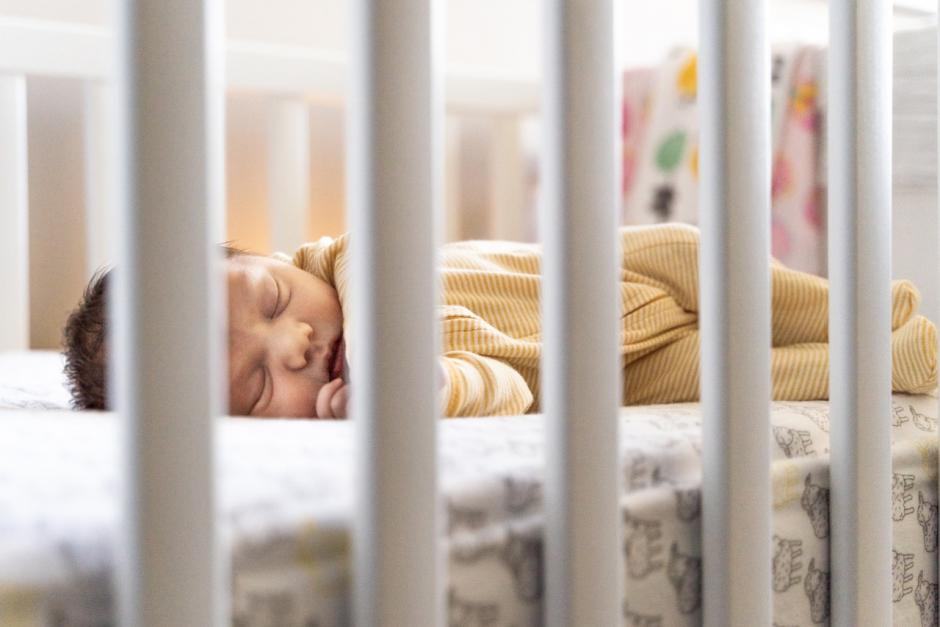Moving your baby from sleeping in your room to their own bedroom is one of the most important steps in their development. Establishing good sleeping habits early in life – including sleeping independently from you – will set your little one up for better sleep throughout their childhood. The chances are, you’ve experienced plenty of sleep deprivation over the past months too. Moving your baby to their own room is a big step in getting back to your old sleep routine.
But it can be difficult for your baby, and also for you. Having them sleeping next to you at night can be a great source of comfort and reassurance for both of you. Bringing this to an end and moving them to a whole different room can be daunting and stressful. Let’s look at the best ways to navigate this change.
What age should my baby move from a Moses basket to a cot?
A common recommendation is to move your baby from a Moses basket to a cot around six months of age.
You can judge this time for yourself however, and you don’t have to follow the six month recommendation to the letter. If your baby is sleeping well in their Moses basket, you can choose to let them stay in there a little longer. If they out-grow the basket, you can move them earlier. And if they can sit up by themselves, you should move them out of their basket, as they could sit up and tumble out.
What age should I move my baby into their own room?
The NHS recommends that your baby should sleep in the same room as you for at least the first six months, as this is safest for them.
If your baby is close to you at night, you’re more likely to hear if they’re having any problems. Sleeping in the same room as you for the first six months has been shown to reduce the chances of SIDS (sudden infant death syndrome).
Most parents move their baby into their own room between six to 12 months of age. Around seven to eight months old, babies start to become more aware of their surroundings at night, and whether or not someone is sleeping close to them. It may make the transition easier if you move your baby at this time before they become too aware of their surroundings at night.
Tips for moving a baby into their own room
Some babies will make the transition to sleeping in their own room with little to no fuss, whereas other babies may find the change more difficult. You can help make the switch go smoother by trying the following:
Spend time in your baby’s room together before you make the move
Make sure you spend time during the day in your baby’s room together, so they are familiar with the room and enjoy being in it. Play in there together, read books, and do whatever your baby enjoys most. This will all help them form positive associations with the room.
Try putting your baby to sleep in their room before you make the move
If your baby has daytime naps, try putting them down in their bed in their new room. Forming a routine of napping in the room can help your baby better adjust to sleeping in there at night.
Sleep with your baby the first few nights
If possible, sleep in your baby’s room for the first few nights when you make the transition. Your presence may relax your baby, help them fall asleep, and help them develop a habit of falling asleep in there.
You can spend the whole night in their room for the first few nights then transition to just being in there as they fall asleep. Finally leaving them in there to fall asleep on their own .
Don’t otherwise change their bedtime routine
Babies take comfort from established routines. Although you’re changing where they sleep, if you keep the rest of your bedtime routine the same, it can minimise any shock and help them adjust faster. If they have a bottle before they sleep, if you read books to them, or whether they have a white noise toy or have other established elements of a routine, make sure you stick to them.
Be consistent
If they don’t adjust easily to being in their new room, they can’t sleep, or they complain and cry, it can be tempting to move them back into your room. Try to avoid doing this, as repeated moving back and forth can prolong the transition and make it more stressful for both of you.
Do what you have to do to make the transition easier on you
All the advice we’ve given so far is about how to make the transition easier for your baby. But moving them into their own room and away from the side of your bed, can be daunting for you too (it may be tougher for you than your baby).
Even if their room is next door to yours, the distance can feel much larger. Take whatever steps you need to, to make the transition less stressful for you too. Use a baby monitor, keep the doors open between your room, sleep on a mattress or camp bed next to your baby for a few extra days. Whatever helps you adjust too.
Adapt to your child and your situation
Your baby is unique and so is your situation. The recommended timings on when to move your baby and the advice we’ve given here can help. But you know your child best and you should feel free to adapt to suit your situation. No one knows your baby and his or her personality and requirements better than you.
Sources:
https://happiestbaby.co.uk/blogs/baby/when-to-move-baby-to-own-room
https://www.childcare.co.uk/information/moving-your-baby-out-of-your-room
https://ohbabyconsulting.com/blog/2020/five-tips-for-moving-your-baby-into-their-own-room/



Leave a Comment: